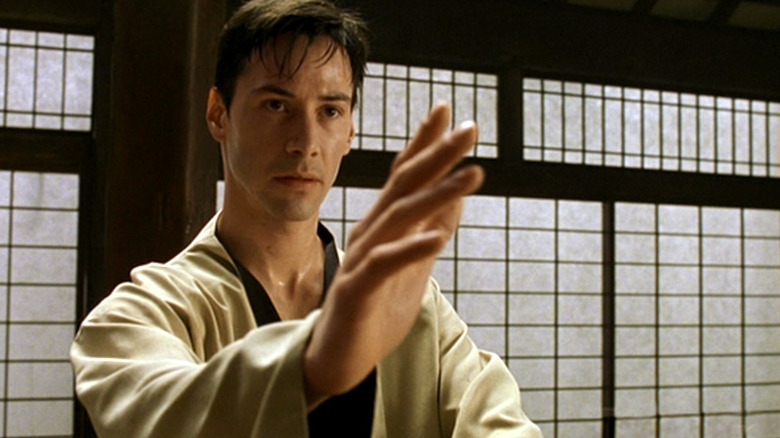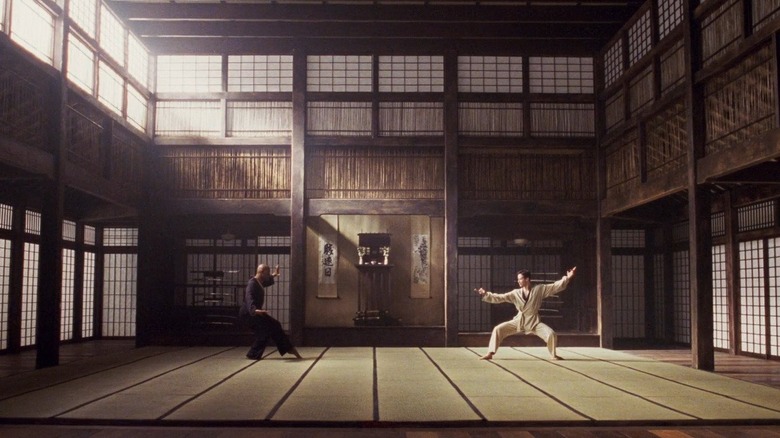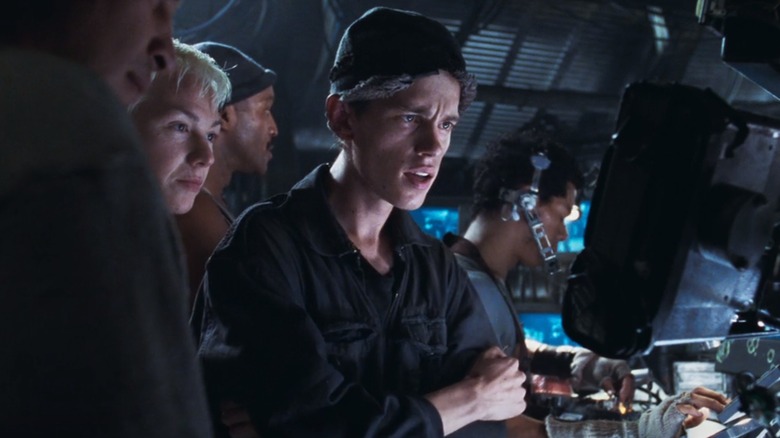Morpheus Vs. Neo In The Matrix Is The Best Action Scene Ever
(Welcome to Best Action Scene Ever, a column dedicated to breaking down the best, most effective action sequences throughout the genre. In this edition, we take on the famous training sequence in "The Matrix.")
The thing about the Wachowskis' "The Matrix" is that you could throw a dart at any of a half-dozen different action sequences and land on one that's more than worthy of this column. The opening moments showcasing the first-ever instance of bullet time practically rewrote the rules for the entire action genre at the time. The set piece beginning with the "deja vu" moment and ending on Morpheus' (Laurence Fishburne) self-sacrificial capture rightfully owns a sizable piece of pop culture real estate all these years later. And the final act of the film unveils one all-timer action scene after another, from the lobby shootout to the rooftop rescue to Keanu Reeves' Neo taking on Agent Smith (Hugo Weaving) and barely coming out on top. Let's just say there's a pretty good reason this film is held up as an action classic well over two decades after the fact.
But one sequence at risk of being overshadowed by the rest deserves its time in the sun, too. It stands apart for taking place outside either the real world or the sinister Matrix itself, set within a self-contained training program and pitting our "chosen one" hero against the one imposing figure in the entire movie thus far who seems to know what's going on. The dojo fight scene between Morpheus and Neo made enough of an impact to be repeated (with a twist) in Lana Wachowski's recent legacy sequel "The Matrix Resurrections," but let's not overlook how this one scene played a crucial role in making the original film the classic that it is.
The scene
By the time "The Matrix" gets Neo (the office drone formerly known as Mr. Anderson) unplugged from the Matrix and into the welcoming but dire situation on board Morpheus' warship, the Nebuchadnezzar, viewers are in desperate need of regaining solid footing again. We've seen Neo's world (and, by extension, our own) thrown completely upside-down thanks to the little reveal that his entire life was just part of a simulation. Struggling to come to terms with such an existential rewiring of the system and thrust into a messianic role that he never wanted on top of it all, the lifelong skeptic Neo and the fervently believing Morpheus are set on an inevitable collision course of worldviews — one that can only begin to be fixed through, well, fists.
Thanks to some exuberance by the ship's operator Tank (Marcus Chong), Neo is uploaded with combat training involving a battery of hand-to-hand martial arts techniques, ranging from jujitsu to kenpō to taekwondo to, yes, kung-fu. A montage speeds us through hours of unconscious training and, by the time he wakes up again, he's finally ready to get back off his heels and reclaim a long-delayed sense of autonomy. That moment arrives when Morpheus challenges him to, essentially, show him what he's got.
Cue the dojo scene, a "sparring program" built for the express purpose of teaching new recruits that "reality" in the Matrix is only what they make of it. Rules are meant to be broken, and that applies twofold to what they previously thought of as gravity, physics, and other real-world constraints. So how best to communicate all these unintuitive, exposition-heavy concepts? As Morpheus puts it, "Hit me ... if you can."
Why it works
It'd be misleading to state that "The Matrix" had been largely action-free to this point, but a revisit makes it startlingly clear just how much the Wachowskis purposefully (and patiently) left audiences primed and ready for a major pick-me-up. After establishing the dystopian reality that Morpheus and his loyal crew find themselves in, a fun and relatively light-hearted sequence to help keep the tone from feeling too oppressive is just what the doctor ordered. Enter Morpheus and Neo in the simulated dojo, where both can finally let loose in broad daylight in a way that we've only glimpsed in the story so far.
After Morpheus takes pains to emphasize the parallels between breaking the "rules" of this program and doing the same with the computer-like limitations of the Matrix itself, the fight finally begins in earnest and audiences get a hint of just what Neo might be capable of. Between the perceptive eyes of the Wachowskis, the talent of director of photography Bill Pope, and the careful editing by Zach Staenberg, the camera itself takes on an almost playful sense of style as it captures the impossibly quick hand-to-hand movements between the student and the master. With brief tilts, stark zoom-ins, and a repeated tendency to physically circle between the two performers as if they were caged animals just waiting to burst outside the screen, everything works in conjunction to sell us on the kineticism and energy of the action — while almost subliminally reinforcing the fact that both Fishburne and Reeves did much of their own stunts here.
But it wouldn't be nearly as effective if it weren't all in service of one vastly important lesson: Neo struggles to hold his own because he's still struggling to free his mind.
The key moment
With so much going on beneath the surface of this otherwise simple and straightforward moment, it'd be easy to point towards the film's wonderfully heady concepts and sci-fi themes as the real reason why this sequence comes together so well. But watching it again, I can't help but point towards something else altogether more fundamental than that. Because when you look at how the editing comes together, it's clear that one clever addition makes everything else sing: the reaction shots of the gawking crew.
It's one thing to sell viewers on the surface-level "cool" factor of what's on-screen, but it's another entirely to show the characters themselves become awestruck by what they're witnessing. The otherwise low-tension fight between Morpheus and Neo ratchets up when the lovable crewmember Mouse (Matt Doran) bursts into the mess hall to announce the fight like it's a can't-miss, WWE pay-per-view event. When everyone scrambles over tables to gather around the low-fi consoles depicting the showdown, viewers feed off that energy and justify the somewhat counterintuitive choice to cut away from the actual fight for seconds at a time.
The turning point comes when Morpheus' tone turns harsher and goads Neo. As a visibly worried Trinity (Carrie-Anne Moss) looks on, the unimaginable happens. Neo finally begins to move faster than humanly possible and nearly lands a punch on Morpheus. Mouse's one open-mouthed muttering of "I don't believe it" is all we need to sell us on the magnitude of the achievement.
Even though we soon see just how far Neo still has to go, the Wachowskis pull off a brilliant cinematic sleight-of-hand by imbuing this sequence with genuine stakes and character development. Thought this moment was just an empty excuse to let loose? Take a cue from Neo and free your mind, too.


